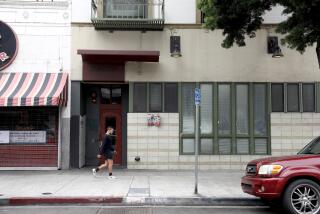$350,000 Cash, Land Used to Settle Perpetual Savings Suit
- Share via
Former directors, officers and shareholders of insolvent Perpetual Savings Bank of Santa Ana have paid $350,000 in cash and turned over a valuable parcel of land to settle an $8.75-million fraud and racketeering lawsuit filed against them by federal regulators.
The settlement with 10 individuals--including co-founders Paul Morady and Andrew E. Stevens--and three companies they operated leaves only two small firms in the lawsuit, according to representatives of Perpetual and the Federal Savings and Loan Insurance Corp., which filed the suit in June, 1987.
FSLIC is the receiver for some of Perpetual’s assets, including all but one parcel contained in a valuable triangular piece of land in West Hollywood bordering Beverly Hills. The S&L; was declared insolvent and seized by regulators in March, 1987, and later was turned over to hired managers to operate.
The cash settlement “seems to be low,” said John R. Faires, Perpetual’s president. But the land parcel, which was located in the middle of the triangle and gave Perpetual complete ownership of the property, “probably raised the total value of the land by $5 million,” Faires said.
He said he hopes that regulators can sell the land for more than $18 million, an amount that would still leave Perpetual with only “a couple of bucks.”
Equity in Question
An FSLIC official said the settlement was “in our interests,” but declined to elaborate.
Christina A. Snyder, a lawyer for Stevens, said she was “very pleased” with the settlement. She said Stevens paid no cash, relinquished claims to $50,000 in commissions and gave the S&L; his equity in the land parcel.
Stevens had once valued that equity at $850,000, but co-defendants--who had filed legal actions against each other--estimated the value at little more than $100,000.
The 120,000-square-foot triangle, bounded by Santa Monica Boulevard, Melrose Avenue and Almont Street, contains 12 buildings on seven lots and such businesses as a flower shop and a gasoline station. It is known as the “Melrose-Doheny Triangle,” a reference to Doheny Avenue, which runs into Melrose at Santa Monica Boulevard.
But Morady, Stevens and others knew that the potential for the land was much greater.
In its suit, FSLIC claimed that they founded Perpetual in 1983 mainly as a means to raise money to purchase and develop the property into an $80-million high-rise hotel complex. More than 20% of the S&L;’s assets went toward purchasing the property. They also acquired interests in the lots for themselves so they could sell them at a profit to the S&L;, the suit claimed.
Through secret commissions and consulting or management fees for alleged work on the hotel project, they managed to squeeze more funds out of Perpetual, the suit claimed.
Further Allegations
And when their scheme began to unravel, they caused the S&L; to pay $1 million for stock in two public companies, the suit said. The stock was vastly overvalued, the suit alleged, and most of the money was used to pay off personal debts of Morady and another defendant, Brent Jay, another director.
Those who paid cash in the settlement were Morady; Jay; Thomas Flores, the S&L;’s former president; directors Murray Fischer and Harold Kapelovitz; and shareholders Michael Morady and Bruce Jay, brothers, respectively, of Paul Morady and Brent Jay.
In addition, FSLIC will turn over some of the stock Perpetual owns in one company to Charles Anshen, a lawyer for that company. He already assigned any interest he received in the stock to his lawyer, Lee Grant. FSLIC considers the stock worthless.
Legal actions the co-defendants brought against each other also were dismissed as part of the settlement, reached in U.S. District Court in April, Snyder said. The settlement was revealed when one of the defendants attached it to a motion challenging its terms. The motion was recently denied.
Meanwhile, the Melrose-Doheny triangle has been draining Perpetual of needed cash.
Though Faires would not disclose how much the S&L; has paid for the property and the continuing debt service, a source said Perpetual was carrying the property on its books for $8 million, was losing $150,000 a month on the deal and had spent a total of $16 million on the purchase, debt service and related costs.
Faires said costs related to the property have been reduced to about $75,000 a month.
The triangle is being marketed by the Federal Asset Disposition Assn., a unit of the Federal Home Loan Bank Board, which also oversees FSLIC. At least six bidders are negotiating to buy the parcel, said Charles H. Fedalen Jr., an FADA staff attorney.
‘Strong Response’
“This is a premier piece of property right now,” Fedalen said. “We have a massive data base of potential purchasers, and we mailed out packages with glossies and six or seven pages of information. We received a strong response.”
Meanwhile, Perpetual lost more than $7.5 million last year and its liabilities of nearly $60 million exceed its assets by $10 million, Faires said. Much of the loss came from write-downs of the value of loans and real estate held by the institution.
Faires said the S&L; is no longer making loans because he believes that an insolvent institution kept open by regulators should not compete with healthy S&Ls; for good quality home loans. With a staff of 12 employees, he said, Perpetual is shrinking itself so it can sell its charter and the tax benefits it has accumulated because of its losses.
More to Read
Sign up for Essential California
The most important California stories and recommendations in your inbox every morning.
You may occasionally receive promotional content from the Los Angeles Times.













